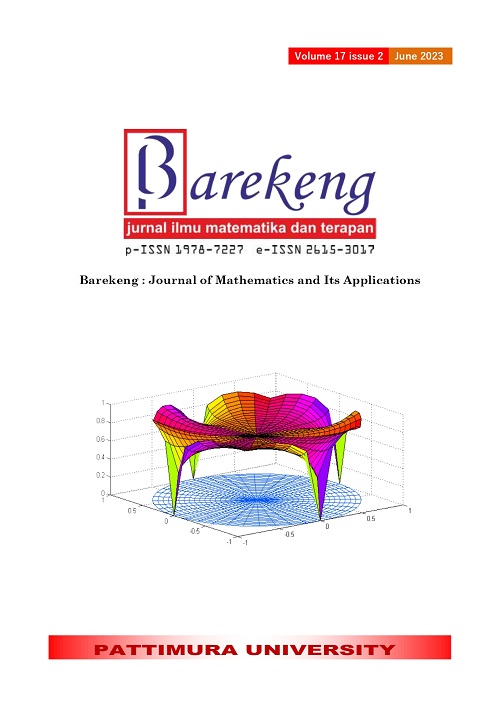DYNAMICAL SYSTEM FOR COVID-19 OUTBREAK WITHIN VACCINATION TREATMENT
Abstract
Covid-19 is a deadly infectious disease that occurs throughout the world. Therefore, it is necessary to prevent the transmission of Covid-19 such as vaccination. The purpose of this research is to modify the model of the spread of the Covid-19 disease from the previous model. The equilibrium points and the basic reproduction number ( ) of the modified model is determined. Then a stability analysis was carried out and a numerical simulation was carried out to see the dynamics of the population that occurred. The analysis performed on the model obtained two equilibriums, namely the disease-freeequilibrium and the endemic equilibrium. Disease-free equilibrium are locally asymptotically stable if . Meanwhile, the endemic equilibrium is locally asymptotically stable if . The numerical simulation results show the same results as the analytical results.
Downloads
References
N. Al-Rousan and H. Al-Najjar, “The correlation between the spread of COVID-19 infections and weather variables in 30 Chinese provinces and the impact of Chinese government mitigation plans,” Eur. Rev. Med. Pharmacol. Sci., vol. 24, no. 8, pp. 4565–4571, 2020, doi: 10.26355/eurrev_202004_21042.
Y. Liu et al., “Clinical and biochemical indexes from 2019-nCoV infected patients linked,” Sci. China Life Sci., vol. 63, no. 3, pp. 364–74, 2020.
P. Zhou et al., “A pneumonia outbreak associated with a new coronavirus of probable bat origin,” Nature, vol. 579, no. January, 2020, doi: 10.1038/s41586-020-2012-7.
CDC, “Coronavirus (COVID-19),” 2020. https://www.cdc.gov/coronavirus/about/index.html (accessed Sep. 12, 2021).
WHO, “WHO Coronavirus (Covid-19) Dashboard,” 2021. https://covid19.who.int/ (accessed Sep. 12, 2021).
KPCPEN, “Data Sebaran dan Vaksinasi Covid-19,” 2021. https://covid19.go.id/ (accessed Sep. 12, 2021).
W. J. McKibbin and R. Fernando, “The Global Macroeconomic Impacts of COVID-19: Seven Scenarios,” SSRN Electron. J., no. March, pp. 1–43, 2020, doi: 10.2139/ssrn.3547729.
OECD, “Covid-19: SME Policy Responses,” Tackling coronavirus Contrib. to a Glob. effort, no. March, pp. 1–55, 2020, [Online]. Available: https://oecd.dam-broadcast.com/pm_7379_119_119680-di6h3qgi4x.pdf
Q. Cui, Z. Hu, Y. Li, J. Han, Z. Teng, and J. Qian, “Dynamic variations of the COVID-19 disease at different quarantine strategies in Wuhan and mainland China,” no. January, 2020.
R. Resmawan, A. R. Nuha, and L. Yahya, “Analisis Dinamik Model Transmisi COVID-19 dengan Melibatkan Intervensi Karantina,” Jambura J. Math., vol. 3, no. 1, pp. 66–79, 2021, doi: 10.34312/jjom.v3i1.8699.
M. A. Khan and A. Atangana, “Modeling the dynamics of novel coronavirus (2019-nCov) with fractional derivative,” Alexandria Eng. J., vol. 59, no. 4, pp. 2379–2389, 2020, doi: 10.1016/j.aej.2020.02.033.
B. Tang, F. Xia, S. Tang, N. Luigi, and Q. Li, “Since January 2020 Elsevier has created a COVID-19 resource centre with free information in English and Mandarin on the novel coronavirus COVID- 19 . The COVID-19 resource centre is hosted on Elsevier Connect , the company ’ s public news and information ,” no. January, 2020.
A. Khan, M. Naveed, M. Dur-e-Ahmad, and M. Imran, “Estimating the basic reproductive ratio for the Ebola outbreak in Liberia and Sierra Leone,” Infect. Dis. Poverty, vol. 4, no. 1, p. 13, 2015, doi: 10.1186/s40249-015-0043-3.
P. Van Den Driessche and J. Watmough, “Reproduction numbers and sub-threshold endemic equilibria for compartmental models of disease transmission,” Math. Biosci., vol. 180, no. 1–2, pp. 29–48, 2002, doi: 10.1016/S0025-5564(02)00108-6.
A. Alam and S. Sugiarto, “Analisis Sensitivitas Model Matematika Penyebaran Penyakit Antraks pada Ternak dengan Vaksinasi, Karantina dan Pengobatan,” J. Ilm. Mat. Dan Terap., vol. 19, no. 2, pp. 180–191, 2022, doi: doi: https://doi.org/10.22487/2540766X.2022.v19.i2.16017.
S. F. Al-Azzawi, “Stability and bifurcation of pan chaotic system by using Routh-Hurwitz and Gardan methods,” Appl. Math. Comput., vol. 219, no. 3, pp. 1144–1152, 2012, doi: 10.1016/j.amc.2012.07.022.
Copyright (c) 2023 Sigit Sugiarto, Ratnah Kurniati MA, Sugian Nurwijaya

This work is licensed under a Creative Commons Attribution-ShareAlike 4.0 International License.
Authors who publish with this Journal agree to the following terms:
- Author retain copyright and grant the journal right of first publication with the work simultaneously licensed under a creative commons attribution license that allow others to share the work within an acknowledgement of the work’s authorship and initial publication of this journal.
- Authors are able to enter into separate, additional contractual arrangement for the non-exclusive distribution of the journal’s published version of the work (e.g. acknowledgement of its initial publication in this journal).
- Authors are permitted and encouraged to post their work online (e.g. in institutional repositories or on their websites) prior to and during the submission process, as it can lead to productive exchanges, as well as earlier and greater citation of published works.






1.gif)



